Page 18 of 106

Safety information
11
EJU30761
Cruising limitations
�Scan constantly for people, objects, and
other watercraft. Be alert for conditions that
limit your visibility or block your vision of
others.
�Operate defensively at safe speeds and
keep a safe distance away from people, ob-
jects, and other watercraft.
�Do not follow directly behind watercraft or
other boats.
�Do not go near others to spray or splash
them with water.
�Avoid sharp turns or other maneuvers that
make it hard for others to avoid you or un-
derstand where you are going.
�Avoid areas with submerged objects or
shallow water.
�Take early action to avoid collisions. Re-
member, watercraft and other boats do not
have brakes.
�Do not release the throttle lever when trying
to steer away from objects—you need throt-
tle to steer. Always check throttle and steer-
ing controls before starting the watercraft.
�Ride within your limits and avoid aggressive
maneuvers to reduce the risk of loss of con-
trol, ejection, and collision.
�This is a high performance boat—not a toy.
Sharp turns or jumping wakes or waves can
increase the risk of back/spinal injury (pa-
ralysis), facial injuries, and broken legs, an-kles, and other bones. Do not jump wakes
or waves.
�Do not operate the watercraft in rough wa-
ter, bad weather, or when visibility is poor;
this may lead to an accident causing injury
or death. Be alert to the possibility of ad-
verse weather. Take note of weather fore-
casts and the prevailing weather conditions
before setting out on your watercraft.
�As with any water sport, you should not op-
erate your watercraft without someone else
nearby. If you operate further than swim-
ming distance from shore, you should be
accompanied by another boat or watercraft,
but make sure you stay a safe distance
away. It’s good, common sense.
�Never operate in water that is less than 60
cm (2 ft) deep from the bottom of the water-
craft, otherwise you increase your chance
of hitting a submerged object, which could
result in injury.
�This watercraft is not equipped with lighting
required for night operation. Do not operate
the watercraft after sunset or before dawn,
otherwise you increase the risk of colliding
UF2H70E0.book Page 11 Thursday, January 15, 2009 10:49 AM
Page 30 of 106
Features and functions
23
Control system
10
11
12 2
20 34
5
1
9876
17
18
19 16
14 15 13
1Remote control transmitter
2Watertight compartment
3Start switch
4Engine shut-off switch
5Clip
6Engine stop switch
7Engine shut-off cord (lanyard)
8Quick Shift Trim System (QSTS) selector
9QSTS selector lock lever
10Multifunction information center
11Beverage holder
12Rearview mirrors
13Throttle lever
14Shift lever
15Tilt lever
16Glove compartment17Up switch (for cruise assist)
18Down switch (for cruise assist)
19“SET” switch (for cruise assist)
20“NO-WAKE MODE” sw itch
UF2H70E0.book Page 23 Thursday, January 15, 2009 10:49 AM
Page 32 of 106
Features and functions
25
EJU31022
Operation of controls and other
functions
EJU31041Seats
To remove the rear seat:
Pull the rear seat latch up, and then pull the
seat off.
To install the rear seat:
Insert the projections on the front of the seat
into the stays on the deck, and then push the
rear of the seat down to lock it in place. Makesure that the seat is securely installed before
operating the watercraft.
To remove the front seat:
(1) Remove the rear seat.
(2) Pull the front seat latch up, and then pull
the seat off.
To install the front seat:
(1) Insert the projections on the front of the
seat into the stays on the deck, and then
1Seat latch
1Seat latch
UF2H70E0.book Page 25 Thursday, January 15, 2009 10:49 AM
Page 33 of 106

Features and functions
26
push the rear of the seat down to lock it in
place.
(2) Install the rear seat. Make sure that the
seats are securely installed before oper-
ating the watercraft.
EJU36682Hood
To open the hood, pull the visor up, and then
lift up the hood.To close the hood, push down on the center
of the hood until it latches securely. Make sure
that the hood is securely closed before oper-
ating the watercraft.
EJU36691Fuel tank filler cap
The fuel tank filler cap is located under the
hood.
To remove the fuel tank filler cap, open the
hood, and then turn the cap counterclockwise.
(See page 26 for hood opening and closing
procedures.)
To install the fuel tank filler cap, turn it clock-
wise until it stops. Make sure that the fuel tank
filler cap and the hood are securely closed be-
fore operating the watercraft.
EJU37121Remote control transmitter
The Yamaha Security System and low-RPM
mode settings are selected using the remote
control transmitter. (See “Yamaha Security1Visor
1
1Fuel tank filler cap
1
UF2H70E0.book Page 26 Thursday, January 15, 2009 10:49 AM
Page 35 of 106
Features and functions
28
switch, such as if the operator falls off the wa-
tercraft. Remove the engine shut-off cord
(lanyard) from the watercraft when the engine
is not running to prevent unauthorized use by
children or others.EJU36281Start switch
Push the start switch (green button) to start
the engine.
The engine will not start under any of the fol-
lowing conditions:
�Lock mode of the Yamaha Security System
has been selected. (See page 35 for
Yamaha Security System lock and unlock
mode selection procedures.)
�Clip is removed from the engine shut-off
switch.
�Throttle lever is squeezed.EJU36700Right handlebar switches
1Clip
2Engine shut-off cord (lanyard)
3Engine shut-off switch
1 3
2
1Start switch
1Up switch
2Down switch
3“SET” switch
4“NO-WAKE MODE” sw itch
1
1
2
3
4
UF2H70E0.book Page 28 Thursday, January 15, 2009 10:49 AM
Page 37 of 106

Features and functions
30
EJU31260Steering system
Your watercraft can be steered by turning the
handlebars in the direction you wish to travel.
When the handlebars are turned, the angle of
the jet thrust nozzle is changed, and the direc-
tion of the watercraft is changed accordingly.
Since the strength of the jet thrust determines
the speed and degree of a turn, throttle must
always be applied when attempting a turn, ex-
cept at trolling speed.
This model is equipped with the Yamaha En-
gine Management System (YEMS) that in-
cludes an off-throttle steering (OTS) system.
It will activate at planing speeds should you
attempt to steer the watercraft after releasing
the throttle lever. The OTS system assists in
turning by continuing to supply some thrust
while the watercraft is decelerating, but you
can turn more sharply if you apply throttle
while turning the handlebars.
The OTS system does not function below
planing speeds or when the engine is off.Once the engine slows down, the watercraft
will no longer turn in response to handlebar in-
put until you apply throttle again or you reach
trolling speed.
EJU31291Tilt lever
The tilt lever is located in front of the glove
compartment and is used to adjust the tilt of
the handlebars. WARNING! Never pull the
tilt lever during operation, otherwise the
handlebars may suddenly change posi-
tion, which may lead to an accident.
[EWJ00041]
To adjust the tilt, pull the tilt lever up, and then
move the handlebars up or down to the de-
sired position.
Make sure that the tilt lever returns to its orig-
inal position and that the handlebars are
locked in place after adjusting them.
1Handlebar
2Jet thrust nozzle
1Tilt lever
1
UF2H70E0.book Page 30 Thursday, January 15, 2009 10:49 AM
Page 38 of 106
Features and functions
31
EJU31301Shift lever
The shift lever is located on the starboard
(right) side of the watercraft and is used to
control the reverse gate, which allows the wa-
tercraft to move in reverse or forward.
When the shift lever is in the reverse position,
the watercraft can be launched from a trailer,
or backed up out of tight spots where you can-
not turn around easily.
EJU31312Quick Shift Trim System (QSTS)
selector
The QSTS selector is located at the left han-
dlebar grip and is used to adjust the trim angle
of the watercraft.
Operating the QSTS selector changes the an-
gle of the jet thrust nozzle vertically. This
changes the trim angle of the watercraft.
1Shift lever
2Forward position
3Reverse position
1
2 3
1Quick Shift Trim System (QSTS) selector
2QSTS selector lock lever
UF2H70E0.book Page 31 Thursday, January 15, 2009 10:49 AM
Page 39 of 106

Features and functions
32
There are 5 positions: 2 bow-down positions
(a) and (b), neutral “N”, and 2 bow-up posi-
tions (c) and (d).
To change the trim angle:
(1) Reduce engine speed to less than 3000
r/min.
(2) Squeeze the QSTS selector lock lever,
and then turn the QSTS selector to the
desired position. NOTICE: Do not turn
the QSTS selector while operating the
watercraft at an engine speed of 3000
r/min or more, otherwise damage
could occur to the QSTS.
[ECJ00012]
(3) Release the lock lever to lock the QSTS
selector.
The neutral “N” position will provide good per-
formance for most operating conditions.To enhance particular types of performance,
select bow down or bow up.
EJU31330Bow down
Turn the QSTS selector to (a) or (b) and the
bow will go down while the watercraft is on
plane.
Bow down puts more of the bow in the water.
This gives the watercraft more “hook”, which
enhances turning performance. This position
will also help the watercraft get up on plane
more quickly.
At higher speeds, however, the watercraft will
have a greater tendency to “bow steer” and
follow waves and wakes in the water. Fuel
economy and maximum speed are also re-
duced.
EJU31340Bow up
Turn the QSTS selector to (c) or (d) and the
bow will go up while the watercraft is on plane.
Bow up puts less of the bow in the water.
There is less water resistance, so straight-
UF2H70E0.book Page 32 Thursday, January 15, 2009 10:49 AM